深港版一年级英文 Primary English For China (Book 2)Unit 9 Fantasy World
- 格式:doc
- 大小:76.00 KB
- 文档页数:10
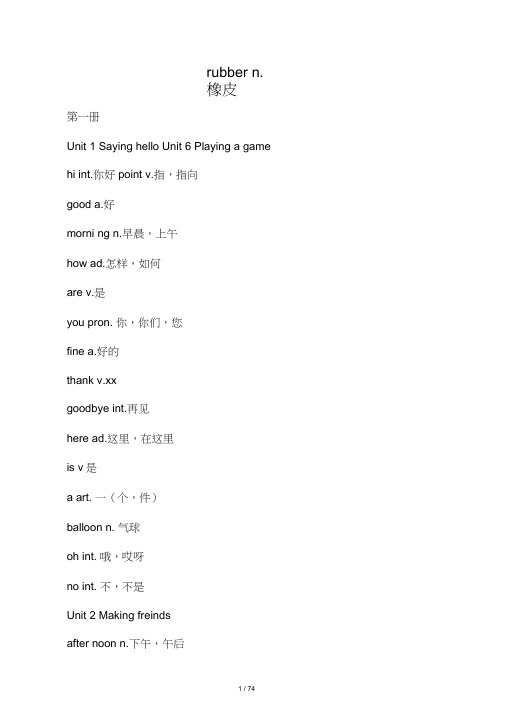
rubber n.橡皮第一册Unit 1 Saying hello Unit 6 Playing a game hi int.你好point v.指,指向good a.好morni ng n.早晨,上午how ad.怎样,如何are v.是you pron. 你,你们,您fine a.好的thank v.xxgoodbye int.再见here ad.这里,在这里is v是a art. 一(个,件)balloon n. 气球oh int. 哦,哎呀no int. 不,不是Unit 2 Making freindsafter noon n.下午,午后I pron.我my pro n.我的n ame n.名字,姓名what pron. 什么your pro n.你的;你们的nice a.令人愉快的;好的meet v.遇见,见到Unit 3 My classroomit pron. 它computer n. 电脑;计算机desk n.书桌chair n.椅子fan n.风扇light n. 灯,灯光book n.书本;本子this pron.这,这个classroom n 教室sorry a.对不起,抱歉Miss n.xx;女士Unit 4 My school thingpen cil n.铅笔pencil case 铅笔盒pen n.钢笔ruler n. 尺子point to 指向the art.这(那)个,这(那)些board n.黑板door n.门window n. 窗look v.看,观看look at (仔细)检查,查看sit v.坐sit down 坐下sta nd v.站stand up 起立ope n v.打开close v.关out adv.出局,淘汰children n.(复)孩子;儿童Mr. (Mister)n.先生(用于姓名please ad. 前)请Unit 7 My bodymouth n. 嘴eye n.眼睛ear n.耳朵finger n. 手指draw v.画画one num. 一nose n.鼻子two num. 二three num. 三four num. 四five num. 五six num.六seve n num.七eight num .八nine num. 九ten num. 十yes ad 是and conj.禾口Unit 8 Fruit an art. 一个,一件apple n.苹果banana n.香蕉lychee n.荔枝orange n.橘子,橙子mum n. (口语)妈妈fruit n. 水果salad n.色拉Unit 9 Colorsred a.红色的blue a.蓝色的yellow a.黄色的gree n a.绿色的orange a.橙色的brown a.褐色的,棕色的me pron.我(宾格)very ad很,非常too ad. 也,还ow int. 啊唷,哦第二册Unit 1pear n.梨stude nt n.学生young a.年轻的pion eer n.先锋,开拓者Young Pioneer 少先队员in prep .在•…里(内)class n.班级grade n.年级boy n.男孩girl n.女孩whatint. 什么(表示惊讶)turn n. (轮流的)顺序It ' s your ti轮到你了Unit 2tall a.高的short a矮的fat a.胖的thin a.瘦的big a.大的small a.小的wow int. 哇not ad.不,没help V.帮助int.救命;来帮帮忙come on 来吧,赶快thanks n.xx,感谢welcome a.受欢迎的You' re welcom e客气。
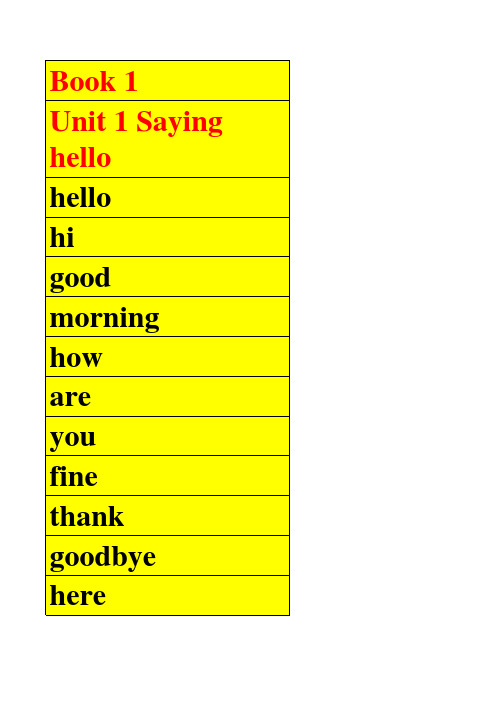
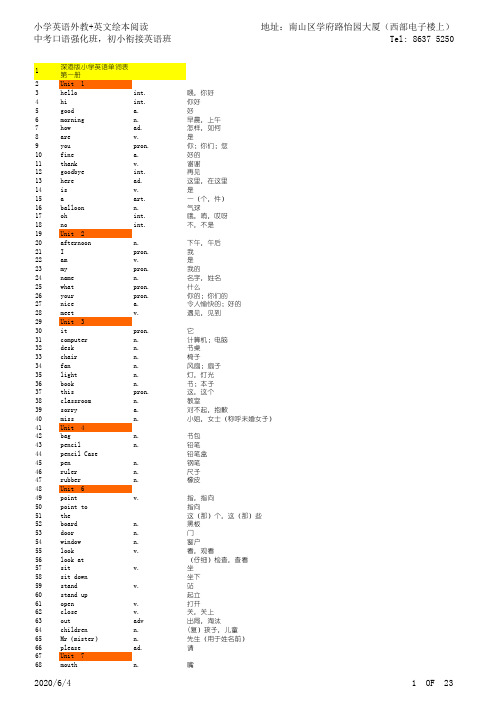
1深港版小学英语单词表第一册2Unit 13hello int.喂,你好4hi int.你好5good a.好6morning n.早晨,上午7how ad.怎样,如何8are v.是9you pron.你;你们;您10fine a.好的11thank v.谢谢12goodbye int.再见13here ad.这里,在这里14is v.是15a art.一(个,件)16balloon n.气球17oh int.哦,哊,哎呀18no int.不,不是19Unit 220afternoon n.下午,午后21I pron.我22am v.是23my pron.我的24name n.名字,姓名25what pron.什么26your pron.你的;你们的27nice a.令人愉快的;好的28meet v.遇见,见到29Unit 330it pron.它31computer n.计算机;电脑32desk n.书桌33chair n.椅子34fan n.风扇;扇子35light n.灯,灯光36book n.书;本子37this pron.这,这个38classroom n.教室39sorry a.对不起,抱歉40miss n.小姐,女士(称呼未婚女子)41Unit 442bag n.书包43pencil n.铅笔44pencil Case铅笔盒45pen n.钢笔46ruler n.尺子47rubber n.橡皮48Unit 649point v.指,指向50point to 指向51the这(那)个,这(那)些52board n.黑板53door n.门54window n.窗户55look v.看,观看56look at(仔细)检查,查看57sit v.坐58sit down坐下59stand v.站60stand up 起立61open v.打开62close v.关,关上63out adv出局,淘汰64children n.(复)孩子,儿童65Mr(mister)n.先生(用于姓名前)66please ad.请67Unit 768mouth n.嘴69nose n.鼻子70eye n.眼睛71ear n.耳朵72finger n.手指73draw v.画画74one num.一75two num.二76three num.三77four num.四78five num.五79six num.六80seven num.七81eight num.八82nine num.九83ten num.十84yes ad.是85and conj和86Unit 887an art一(个,件)88apple n.苹果89banana n.香蕉90pear n.梨子91lychee n.荔枝92orange n.橙子93mum n.(口语)妈妈94fruit n.水果95salad n.色拉96Unit 997red a.红色98blue a.蓝色99yellow a.黄色100green a.绿色101orange a.橙色102brown a.褐色的,棕色的103me pron.我(宾格)104very ad.很,非常105too ad.也,还106ow int.啊哊,哦108深港版小学英语单词表第二册109Unit 1110student n.学生111young a.年轻的112pioneer n.先锋,开拓者113Young Pioneer少先队员114in prep.在……里面115class n.班级116grade n.年级117boy n.男孩118girl n.女孩119what int.什么(表示惊讶)120turn n.(轮流的)顺序121It's your turn. 轮到你了。
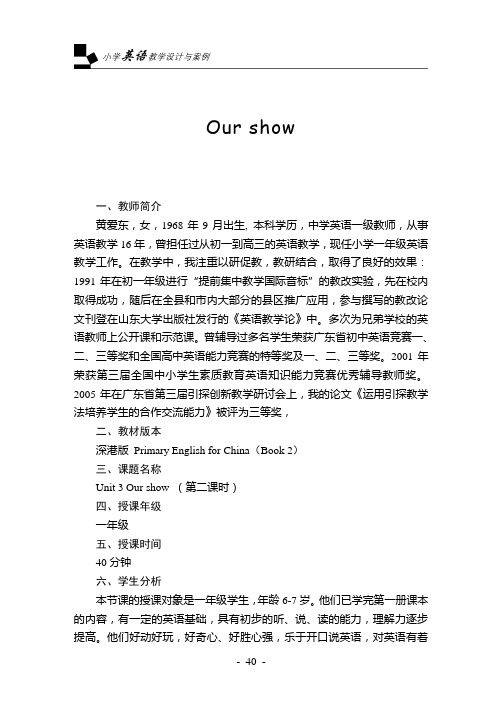
Our show一、教师简介黄爱东,女,1968年9月出生, 本科学历,中学英语一级教师,从事英语教学16年,曾担任过从初一到高三的英语教学,现任小学一年级英语教学工作。
在教学中,我注重以研促教,教研结合,取得了良好的效果:1991年在初一年级进行“提前集中教学国际音标”的教改实验,先在校内取得成功,随后在全县和市内大部分的县区推广应用,参与撰写的教改论文刊登在山东大学出版社发行的《英语教学论》中。
多次为兄弟学校的英语教师上公开课和示范课。
曾辅导过多名学生荣获广东省初中英语竞赛一、二、三等奖和全国高中英语能力竞赛的特等奖及一、二、三等奖。
2001年荣获第三届全国中小学生素质教育英语知识能力竞赛优秀辅导教师奖。
2005年在广东省第三届引探创新教学研讨会上,我的论文《运用引探教学法培养学生的合作交流能力》被评为三等奖,二、教材版本深港版Primary English for China(Book 2)三、课题名称Unit 3 Our show (第二课时)四、授课年级一年级五、授课时间40分钟六、学生分析本节课的授课对象是一年级学生,年龄6-7岁。
他们已学完第一册课本的内容,有一定的英语基础,具有初步的听、说、读的能力,理解力逐步提高。
他们好动好玩,好奇心、好胜心强,乐于开口说英语,对英语有着浓厚的兴趣及热情,但有意注意时间短,自制力差。
七、课标分析《英语课程标准》指出:“采用活动途径,倡导体验参与,让学生在教师的指导下,通过感知、体验、实践、参与和合作等方式,实现任务的目标,感受成功。
”因此,在本节课的教学中要充分利用学生好动、爱说、爱唱、喜欢表演、善于模仿等特点,教师要启发、引导和帮助学生通过说、唱、游戏等方式吸引他们的注意力,让他们积极、主动、大胆、愉快地参与到教学活动中来。
八、教材分析1.本课是一年级第二册的第三单元,第二课时。
2.学生在第一课时已经学过一些表示动作的单词,如:draw , sing , dance , run , jump , read ,write 等,并能做一些相应的TPR活动。
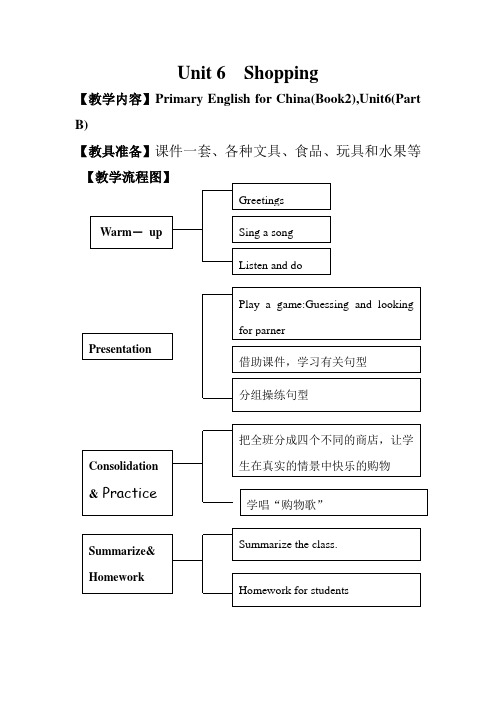
Unit 6 Shopping【教学内容】Primary English for China(Book2),Unit6(Part B)【教具准备】课件一套、各种文具、食品、玩具和水果等1. 【教学目标】1能听懂、会说新单词:may 、 pizza 、hot dog 、ice cream 等。
掌握并扩展新句型“Can I help you ?”2. 掌握会话中有关句型并能进行扩展性的情景会话。
3 通过“在商店里”这个实用又常见的情景话题,激发学生学习语言的兴趣,培养他们学习英语的积极态度,使学生乐于合作参与,勇于交际实践。
【重点、难点】掌握会话中有关句型并能进行扩展性的情景会话。
【板书设计】【教学步骤】Warm -upStep1:GreetingsT:Good morning,children. What is the weatherliketoday?now,let us listen and do:Jump、jump、jump like a rabbit;Walk、walk、walk like a duck;Swim、swim、swim like a fish;Fly、fly、fly like a bird;Swim、swim、swim like a baby.T: Good,boys and girls,you did a good job!Step 2:Presentation1.Lead inNow,let`s play a game and look for the partner,OK?师出示课件,让学生摘取“神奇之果”并出示实物让学生归类组成一个个的商店(KFC、fruit shop、book shop、toy shop)为接下来的教学环节埋下了伏笔。
T:(Point to the objects)Wow! They’re pretty! Do you like them?PresentationNow,let’s go shopping and buy them.(Read the title “Unit 6 Shopping”2,Play a guessing game(出示课件,猜价格)2.T:What’s the girl going to buy?(课件:顾客走进一家水果店,与售货员进行交谈)Shopkeeper=S girl=G3 Practice<1>Listen to the dialogue.T:What have you heard in the dialogue?<2>listen to the tape and repeat it sentence by sentence.<3>Practice in group of two.S: Can I help you?(Learn to say :“Can I help you?”)G:May I have six pears,please?S:Yes,here you are.Twelve yuan please.S:(Get the money)Thank you.<4>Prompt a pupil to ask for something and then hide the objects, saying” Sorry, I have no …” Check that the pupils can make similar replies by asking them for something they don’t have.Step 4:Consolidation1 Divide all the students into group offour.Get the students to do shoppingin groups.2Ask the students to go to differentshops and buy different things.3 教师总结全课,表扬做得好的学生。
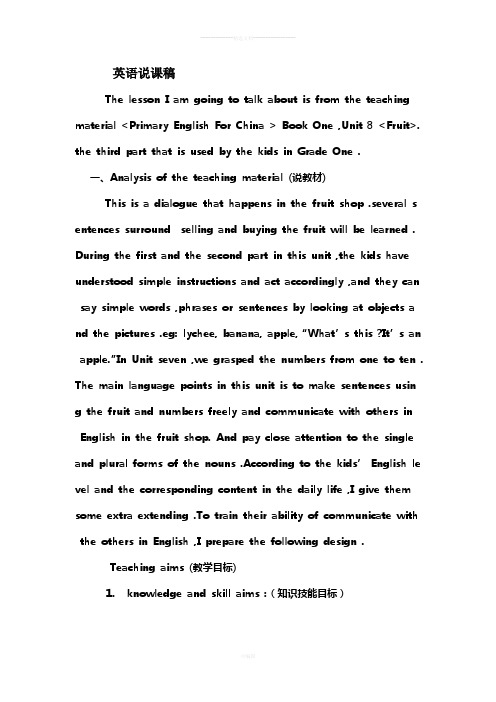
英语说课稿The lesson I am going to talk about is from the teaching material <Primary English For China > Book One ,Unit 8 <Fruit>. the third part that is used by the kids in Grade One .一、Analysis of the teaching material (说教材)This is a dialogue that happens in the fruit shop .several s entences surround selling and buying the fruit will be learned . During the first and the second part in this unit ,the kids have understood simple instructions and act accordingly ,and they can say simple words ,phrases or sentences by looking at objects a nd the pictures .eg: lychee, banana, apple,“What’s this ?It’s an apple.”In Unit seven ,we grasped the numbers from one to ten . The main language points in this unit is to make sentences usin g the fruit and numbers freely and communicate with others in English in the fruit shop. And pay close attention to the single and plural forms of the nouns .According to the kids’English le vel and the corresponding content in the daily life ,I give them some extra extending .To train their ability of communicate with the others in English ,I prepare the following design .Teaching aims (教学目标)1.knowledge and skill aims :(知识技能目标)Review the names of the ten different kinds of fruit and recognize the numbers from one to ten .Understand simple instructions about the numbers and actaccordingly.Practice English and communicate with others in the situati on.2.Equip them with the emotion ,attitude and value goals:(情感、态度、价值目标)Cultivate the spirit of co-operations in the group work..Bring up the good quality of protect and make friends wi th the animals .Teaching importance :(教学重点)1.Make sentences using the fruit and the numbers . “Sixoranges ,please .’2.Distinguish the difference between the single form andthe plural forms of the nouns .“one apple / two apples …”3.The sentences used when selling and buying the fruit in a fruit shop.Teaching difficulties :(教学难点)1.Distinguish the difference between the single and theplural forms of the nouns .2.Train their ability of communicating with others in English .Teaching aids ;(教具准备)Multimedia , flash cards ,fresh fruit and arrangements anddecorations of the fruit shop .Teaching methods :(教学方法)Task objective teaching method .TPR method , performance and games methods .二、Analysis of the learners :(说学习者)We are facing the 5 to 6-year-old little kids who just gradu ated from the kindergarten ,and they can not tell the difference between kindergarten and the primary school. sometimes they e ven don’t know how to behave in the class. So ,I think the mos t important thing for me to do is to attract their interests and make them love English and feel confident in this subject .so ,I will play some interesting games with them ,show them the fun ny cartoon movie and role the plays in the text or have a comp etation. we should not only focus on the language point itself ,b ut also set up the real circumstance where I can encourage the m to express themselves better .What I try my best to do is to arouse the kids’ interests and protect their enthusiasm。
At the zoo一、教师简介我是盐田区庚子首义中山纪念学校的英语教师,小学英语教学经验5年,积极参与教改实验,担任了广东省教育厅科学“十五”规划课题《儿童兴趣教育研究》的子课题《故事教学法在儿童英语学习中的应用》的实验老师,多篇论文获得国级一等奖和省级二等奖,2005年获得引探教学法说课比赛二等奖,盐田区思品课程说课一等奖,在盐田区英语教改课例展示上获优秀课例奖。
二、教材版本深港版Primary English for China (Book 2)三、课题名称Unit 4 At the zoo四、授课年级一年级五、授课时间40分钟六、学生分析本课的授课对象是小学一年级学生,他们的特点是活泼、爱玩、学习兴趣高但注意力难以持久。
有些同学在幼儿园的时候已经简单地学过了一些动物的单词,如dog, cat, monkey等等,不过也只是停留在对图片的认读上,对单词的认读和对动物的整体认识以及口语交际方面还比较薄弱。
学生经过了一个学期的学习,已经对英语产生了浓厚的兴趣。
他们比较熟悉老师的指令语,能够积极地参与课堂教学活动,并能做一些相应的TPR活动,这些都为这节课打下了基础。
七、课标分析新课标对本课内容的总体要求为:能够将本课的内容与已教授的知识进行合理的整合,能够为后面的教学奠定良好的基础。
学生能够运用本课的语言知识进行简单的英语交际和信息交流。
要合理发掘本课的德育内容,将知识的传授、能力的培养和品德教育有机地结合起来。
八、教材分析本课为深圳市小学英语教材Primary English for China第二册第四单元“At the zoo”的A部分。
由于本单元有7个部分,从教材的整合来说,本部分既是对第一册学习颜色的巩固和延续,又为本册第七单元学习宠物打下基础,具有承上启下的作用。
再则,从本单元来说它既是本单元的基本语言内容,又为本单元知识扩展和综合语言运用奠定坚实的基础。
因此,上好本部分,既可让知识学习具有一定的延续性,又可为下面的教学做好铺垫,对完成本单元和今后的英语教学具有重要的意义。
Unit 9 Colours单位及作者:深圳市光明新区马田小学卢碧怡◆本单元是深圳版Primary English for China教材一年级第一册的第九单元,这个单元的主要话题是颜色。
本单元的知识结构合理,符合孩子们学习英语的方法,并且接近孩子们的生活。
既让孩子们学会新的内容thecolours, 又让他们巩固了第三第四单元所学What’s this? This is a…It’sa …等句型。
◆本单元要求孩子们会听、说、读、写六个颜色单词,并能流利地运用英语来谈论颜色。
◆本课的授课对象是小学一年级第一学期的学生,年龄6~7岁。
他们学习英语的经验较少。
但是他们乐于参与课堂活动,在课堂上大部分学生活泼好动、爱说爱演爱表现,喜欢各类游戏。
可是自控能力弱,注意力不能持久。
所以课堂的设计必须适合孩子们的普遍特点,并能够激起他们学习英语的兴趣。
1.语言知识目标:◆理解并能听、说和认读单词:red, blue, yellow, green, orange, brown, me,very, too 等单词。
◆理解并能听、说和认读句型,如:This is a/an…It’s…What’s this?◆能准确地理解文中句子的含义。
2.语言技能目标:◆并能运用一般现在时态来描述颜色,例如This is a/an… It’s…◆能运用What’s this?来提问,并用It’s a/an…This is a/an….做出相应回答。
通过模仿、操练、表演等活动,学生能够在真实的情景中熟练地运用所学的语言知识,做到学以致用,培养学生的口语交际能力。
◆促进学生积极思考,运用本课所学语言进行创造性的加工练习。
3.学习策略目标:◆本课主要通过TPR教学、“情境”教学、任务型教学和引探教学,创设良好的语言学习环境,让学生在TPR活动中掌握语言知识,在完成任务时运用和巩固语言知识,在“情境”中进行口语交际,提高学生运用语言和英语交际的能力,在引导和探究的过程中提高学生的观察力、想象力和团结协作的能力。
教学设计深圳市罗湖区怡景小学林玉冰教材《Primary English For China》的使用已有几年,但从现在五、六年级学生的学习情况看,有相当部分学生不愿背单词和记忆单词,甚至完全放弃。
究其原因,在低年级的英语单词教学没有引起足够的重视,只教听、说,没抓读、写,特别是没有教给学生科学的记忆方法,造成他们今天的学习困难。
因此,如何教给学生科学的学习单词的方法,使他们愿学、乐学,又学得好?是我们英语教学的当务之急,也是我们责无旁贷的责任。
根据《英语课程标准》的精神,以及小学生的生理和心理特点和认知水平,本人认为小学英语教学的主要目标应该是:培养小学生的学习兴趣,良好的学习习惯,良好的语音基础,初步的语感和用英语进行简单的日常交流的能力;培养学生初步的观察、记忆、思维、想象能力和自主学习能力。
如何在一年级的英语教学中贯彻这一精神?根据一年级学生活泼、好动的特点,本人设计了以活动为主要上课形式,创设真实情景,让学生在情景中学,在情景中练,在情景中用,在情景中思考。
极大地激发了学生的学习兴趣,同时浸透语音教学,教给学生科学记忆英语单词的方法,使单词的学习变得容易,变得有趣,减少学习难度。
下面是本节课的教学设计:A teaching plan▲Shenzhen Yijing Primary School Lin Yubing▲《Primary English For China》▲The first period, Unit 9 Fantasy World (Book 2)▲Pupils of Grade 1▲One priod (40 minutes)The first periodTeaching Content: Unit 9 Fantasy World Part ATeaching Aims:1.To use the modal verb ‘can’ and the verb ‘to see’2.To know the countable nouns and uncountable nouns.3.To know that animals are our friends and the importance of protecting theenvironment well.Important points:1.Be able to listen, say understand and use the words of Part A.2.Be able to pronounce the words according the rules.3.Be able to use the sentence what can you see?I can see………..Difficult points: The pronunciation and the spelling of the words.Teaching tools: Picture cards, word cards, a telescope, a multimedia computer, etc.Teaching steps:Setting of the desks. (课前准备)这节课的设计是以活动为主要上课形式,因此我对课桌的摆放进行了调整,在课室中间留出一块空的地方,以便学生活动和表演。
(如下图)把学生分成七个小组,以便小组活动更方便,学生之间交流更多。
教师大部分时间在同学们中间组织活动,从而使教师与学生的距离拉近,使学生倍感亲切,能更好地调动学生的学习积极性。
Step1 Warm up and revision1.Sing a song.( 设计意图:通过唱英语歌曲,激活学生学习英语的热情)。
2.Greetings.T: How are you, children? Are you Peter? Glad to see you again.etc. (设计意图:利用简短的几句寒暄,拉近师生间的感情距离,使教学活动得于顺利进行。
)3.Revise the sentences with ‘can’.T:What can you do?P: I can sing. (dance, run, read, write, jump etc)(设计意图:通过提问,复习带can的句型,和部分单词,为下一步的教学打下铺垫)Step2 Presentation1.Show the video of Part A. T. points the picture and says: This isa Fantasy World. (设计意图:引出课题,并写在黑板带读,让学生初步对Fantasy World 有印象)T: Do you want to go to the Fantasy World?Ps: Yes.T: I’ll take you to go there. But first let’s learn the words.2.Show the words learned. Tell pupils to read them. Then encouragepupils to pronounce the new words according to the rules.3.⑴ Learn the word‘slide’. (先出示学过的like fine, 让学生读, 然后教师把单词卡like ,fine 折成两半,如:sl 一半,ide一半,分别带学生读ike, ine,让学生领会“i”在这些单词中的发音,然后出示slide, 部分学生能很快正确读出slide, 因为在教字母阶段已教过大部分辅音的发音,然后教师把单词再带读,让学生领会“i”在这些单词中的发音,从中找到规律。
以下单词以同样的方法教。
)⑵ swim this fish swim(3) grass classroom grass(4) tree green three tree(5) clown down brown clown(6) flower⑺ swimming pool zoo too swimming pool(8) Learn the word ‘see’.T:(Point to the picture cards and ask.)What can you see?(教师做动作,让学生明白see 的意思,引导学生回答。
)Ps:I can see a flower/flowers.(出示这课单词的单复数图片,学习名词的单复数形式,出示grass时,提醒学生不能念成a grass.只能念I can see grass.)4.Write the key sentences and the words on the board. Then read.(设计意图:使学生对本课重点内容有个清晰的了解。
)Step 3 Practice and consolidationActivity 1 Match the word cards and the picture cards.(教师把刚学的单词,每个分成两半,如tr/ee, sl/ide等,边带读sl/ide边发给学生,分别给两个学生,准备足够的卡片和图片,每个学生都有一张,发完后,教师念slide, 拿着sl和ide的学生和拿着图片的学生都要站到前面来,并按单词的拼写顺序排好,拿图片的也站在旁边,组成两个或三个slide和一张图的一个队型,这时全班看着前面齐读一遍。
这个活动的设计意图是复习、巩固单词的音、形、义。
强化学生对发音规律的认识,锻炼学生的观察能力和记忆能力。
全班参与,对性格内向、学习有困难的学生有好处,能消除他们的紧张心里,使他们学得轻松、愉快,激发学习兴趣。
)Activity 2 Finish the teaching picture.(拿出一幅未贴上单词的教学图,相似书上A部分的图,教师拿卡片准备贴,T:I am going to put the word cards on the pictures.却不小心撒了一地,T:Oh,No. Who can help me? 这时有学生会说:I can help. 这些单词卡也是分成两半的卡,目的让学生连起来再贴上去,教师问:What can you see? 学生答:I can see…把找到的告诉老师,并贴在图上,教师及时说Thank you。
这个设计具有真实性,学生在不知不觉中运用英语,锻炼了观察能力和思维能力。
在活动中同时体现了师生之间的关爱、平等、和谐。
)Activity 3 Take pupils to see a Fantasy world.⑴ Show a big CAI. (图上除了这节课学的单词,还有动物和其它)T:I will take you to see a Fantasy world. Please take out your telescopes and watch carefflly.(教师边说边架好一个望远镜,通过望远镜看上面的图,并说:I can a.... What can you see? 学生拿着自己做的望远镜说:I can see flowers. (grass, a rabbit, monbeys, elephantsetc.全班学生参与。
设计意图:复习、巩固本节课知识和旧知识,培养学生观察能力和思维能力。
)⑵ Show a small CAI. (把刚才的图放到很小,几乎看不到具体的物体,再问学生:What can you see? 学生看不到,可能会说I can’t see...或摇头,这时教师装模作样在望远镜前说:I can see an elephant. It’s big. It’s grey. 叫一学生过来看,并示意叫他说。
希望多些学生上来说.设计意图:培养学生思维能力、想象能力和综合运用英语的能力。
) Activity 4 Finish a matching exercise in a group. (发给每个小组一张练习纸,小组完成,要求学生圈出单词,边连线边说:I can see a slide. etc. 如果时间不够,可作为课后作业。
设计意图:巩固所学知识,培养学生观察能力,记忆能力和合作精神。
如下图:)CatslidedlldograssyoutreesnaflowerswayercrowntheorswimmingpoolpetteStep 4. Summing upT.points to the CAI and says:That’s a Fantasy World. Do you like Fantasy World? There are...in the Fantasy World. Do you like animals? Animals are our good friends. We should take good care of them. We should cherish every tree and every flower. Do you remember the words? Let’s read again.( 设计意图:总结本课教学并教导学生热爱大自然,热爱生命。